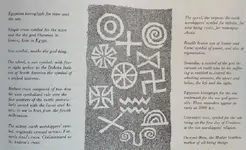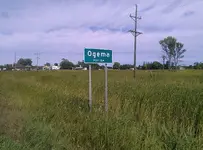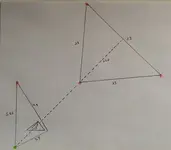I never paid any attention to cemeteries until I read New Mexico Confidential. Steve's friend, Jim Weaver, gave some good things to look for in cemeteries.
I was lucky to have some clues that directed me to a cemetery, but what would you look for if you don't have a manuscript or a carving to guide you to such a place? I'll list a few things that I have found, that you can look for in the county you live in. I'm not saying it's gonna work for you, but it's something you can check out close to home. Maybe some of the other members will add some things.
1. Check out the map collections at your local library and look for county maps from the late 1800's. Try to find the type of map that shows towns and place names instead of the maps that show property lines and owner names. Find all the cemeteries in your county map and make sure you find the names of all of them.
2. Take each name and substitute the alphabetic number for each letter in the name, example: A=1, B=2, C=3 and so on. Look for any names that have numbers that add up to 74. Here's another example: LEROSE cemetery. L=12, E=5, R=18, O=15, S=19, E=5. Add the numbers up and you get 74. I believe 74 is a number of importance to look for when you're checking out cemeteries. I've never been able to find out why 74 would be an important number, but Dr. Syn offered a suggestion that it might be a backward 47 and might refer to the 47th Problem of Euclid.
47th PROBLEM OF EUCLID - What is the meaning of this Masonic Symbol? This would make sense because I've found several right triangles associated with the number 74. If you find a 74 association, these would be the cemeteries to check out first.
3. If you don't find any 74 cemeteries look at your map and see how the cemeteries are marked. The map I use has the cemeteries marked, cem with a cross next to it. The cross could be above the cem, below it or to the right or left of it. I've found that when the cross is to the right of the cem, that there is a 74 association at that cemetery. The association that I've found has been a family plot size of 74 feet, for example, a plot that measures 18 feet by 19 feet which adds up to 74.
4. If you have found any cemeteries of interest check out each one. When you go to a cemetery the first thing to look for is the biggest obelisk in the place. This tip came from Steve's friend and has proven useful to me. If there is an obelisk inside a family plot, measure the sides and see if you have a 74 foot plot. If you do have a place like this, you could have a large right triangle setup covering many miles.
5. As you try to find out if there is a right triangle setup, look for anything that might give you a direction to go from the obelisk. I found a row of medium size evergreens that where planted to show an arrow pointing south. If you don't have an obelisk, if there's a different monument inside the 74 plot, look for something on the monument that will give direction, maybe a hole to site through or something in the distance that lines up with the monument.
6. If you find a direction, it's time to look for the points of the right triangle. I've found google earth to be real helpful when I'm ready to run lines. Go in the direction indicated and look for something that sticks out, it could be 5 or 6 miles away, maybe more. Look for landmark place names, other cemeteries, mills, odd shaped buildings, unusual manmade landscape features, something that sticks out. I found a heart shaped pond about 6 miles straight south.
7. Now you have to find the third point. I would guess that the 74 cemetery plot will be to the north and the long line of the right triangle will be to the south. When you know these two points it will make it easy to find the right angle point. When you do find the right angle point, you might want to go to that place and look for some treasure related carvings or rock formations. You might even want to interview some of the local people and see if you can learn of any unknown treasure legends associated with that place.
If you don't have any luck with this stuff, you will have learned some things about your counties history. Those old graveyards are like an historical index.





 The XXX's around the symbol are just me hiding the real letters and code, The K's are what is actually there on the piece. K was not coded and given in plain text all through this trail.
The XXX's around the symbol are just me hiding the real letters and code, The K's are what is actually there on the piece. K was not coded and given in plain text all through this trail.  ,but you get the general idea of how the death star looking symbol is used in our case. Thanks for posting the picture MD!
,but you get the general idea of how the death star looking symbol is used in our case. Thanks for posting the picture MD!

